#echino
Explore tagged Tumblr posts
Text




Redrawing this character every year since her creation in early 2023.
Echino was born on Baryte in a litter of four, being the runt of said litter her parents worried that if she wouldn't survive, and when she did make it to toddler age, they began to instead worry she would simply not be able to amount for much. But as Echino got older and began to understand her parents' fears, she vowed to prove them wrong.
Echino began apprenticeship under a senior hunter in the sept by the name Meloi, and began learning to hunt, trap and fight under the older aviset's guidance. She was a very persistent student, never allowing her failures to keep her from learning, though she gained some scarring along the way. Eventually she reached a point where she was able to hunt on her own, and from there she quickly started rising in the ranks as she trapped all kinds of prey. As she got older she got more ambitious, targeting the larger and more dangerous animals of Baryte. She became a prized trapper within her sept, no longer was she doubted, but still she was driven to do more. She made it her goal to trap every kind of animal there was to trap on Baryte. That goal was, after several years of hunting, completed. And with it..she found the drive to do more still.
She left Baryte behind to hunt new prey elsewhere, and it was during her travels she came across a bounty hunter's guild. It was perfect, a way to keep hunting, but now her targets posed more of a thrilling challenge.
#art#digital artist#kirby right back at ya#digital art#kirby oc#hoshi no kirby#kirby#kirby series#kirby art#kirby wolfbell au#aviset#original species#echino#bounty hunter oc#character redraw
28 notes
·
View notes
Text

1 note
·
View note
Text

I need to go to the desert I fear
11 notes
·
View notes
Text
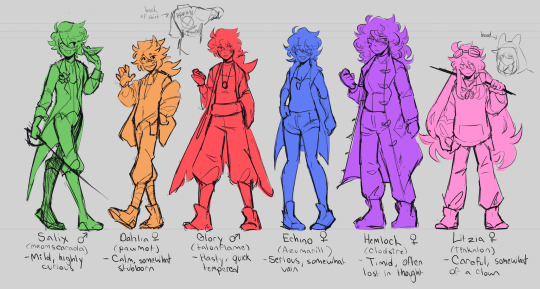

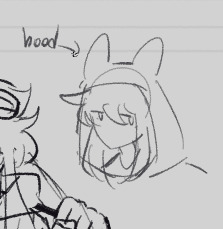
doodles of my scarlet gijinkas
#g art#pokemon gijinkas#theyre named after plants.. some of their names are shortened versions of their latin names idk#usually ill make gijinkas of my champion team after i finish the game but something happened with scarlet and i... forgot to do that!#for a whole year i forgot. wow#uh i have no notes but i thought echino was a boy for a good solid 50 levels throughout my playthrough#because i confused her with my other azumarill
11 notes
·
View notes
Text
Xương rồng Echino - Chàng lùn xương rồng đáng yêu "đốn tim" hội mê cây
Nếu bạn đang tìm kiếm một loại cây cảnh mini vừa xinh xắn, vừa dễ chăm sóc, lại mang ý nghĩa phong thủy tốt đẹp thì Echino chính là ứng cử viên hoàn hảo!

Echino có gì đặc biệt?
✨ Vẻ ngoài độc đáo: Echino có hình dáng giống như một ngọn tháp thu nhỏ với những nhánh mọc xung quanh vô cùng đáng yêu. Gai của Echino nhỏ và mềm, không hề "đáng sợ" như những loại xương rồng khác đ��u nhé!
💪 Sức sống mãnh liệt: Echino rất dễ trồng và chăm sóc, thích hợp cho cả những người mới bắt đầu "tập tành" làm "con sen" của cây cảnh.
💚 Ý nghĩa phong thủy: Echino tượng trưng cho sự may mắn, kiên trì, vươn lên trong cuộc sống và tình bạn bền chặt.

"Bí kíp" chăm sóc Echino:
☀️ Ánh sáng: Echino là "fan cứng" của nắng, hãy cho "em ấy" tắm nắng mỗi ngày nhé!
💧 Nước: "Uống nước" vừa đủ là được, đừng để Echino bị ngập úng nha!
🌱 Đất: Thoáng khí, thoát nước tốt là tiêu chí hàng đầu khi chọn đất cho Echino.
🪴 Nhân giống: Siêu dễ bằng cách tách nhánh hoặc gieo hạt.
[Hình 2: Ảnh chụp Echino với nhiều kích thước/kiểu dáng khác nhau]
👉 Xem thêm chi tiết về cách chăm sóc Echino tại: https://kiengla.vn/xuong-rong-echino/
Kiểng Lá VN
🌐 Website: Kiengla.vn
📞 Phone: 0394.853.724
📧 Email: [email protected]
📍 Địa chỉ: 30A đường số 14, phường Linh Đông, thành phố Thủ Đức, TP.HCM
0 notes
Text
Polaris: "title:field guide to creatures and beasts first edition author:coleman burdain"
Maristela: "revenge how"
Marisa: "how to cast explosive dust THIS IS 4 A PAPER BTW SHERIFF"
what would be some of your ocs recent google searches?
300 notes
·
View notes
Photo

Thistle
Near Chersonissos, Crete.
0 notes
Text
Two new important archeological discoveries have emerged in Greece – a gate sanctuary found at the Minoan palace of Archanes on the island of Crete and a tomb believed to date from the time of Philip II, father of Alexander the Great, found in Pthiotis, Thessaly.
The gate sanctuary at the Minoan palace of Archanes will help shed more light on the site’s religious and architectural importance, experts say.
“Archaeologist Dr Efi Sapouna-Sakellarakis continued the archaeological research to complete the image of the three-storey building, which along with Knossos [the biggest Minoan palace on Crete], played an important role in the development of the Minoan civilization,” the Greek Ministry of Culture said on October 23.
“It is a gate sanctuary, a unique element, found for the first time in a Minoan palace, outside its main entrance, in the same place where four altars have been uncovered, as well as the two arms of the stone construction of the platform, which as a whole indicate the religious importance of the place,” the ministry added.
The Minoan city of Archanes and palace complex, built around 1900 BC, lies in a small closed valley, 15 km south of Knossos palace. The site was discovered in the 1960s.
Various findings from Archanes and the wider area confirm the existence of continuous habitation. Columns, figurines and statues are examples of important art that developed in the area.
The bronze age Minoan Civilization flourished from around 3000 to 1450 BC in Crete and other Aegean islands, especially in the Cyclades. It was one of the first advanced civilizations in Europe, which left behind large building complexes, tools, works of art, writing systems, and an extensive trading network reaching both Cyprus and Egypt.
The media outlet Lamia Report reported meanwhile that on October 23, construction works at the village of Echinos, in Fthiotis, had revealed a large tomb, alleged to be a Macedonian one.
Echinos was a town in ancient Thessaly founded by the Thebans during the period of Theban hegemony. Philip II took control of Echinos to facilitate his passage from Thermopylae.
The construction works have been stopped to enable archeologists to uncover the burial monument. Objects from the tomb unfortunately have been stolen already, probably long ago.
10 notes
·
View notes
Text
DIY Zippered Throw Pillows
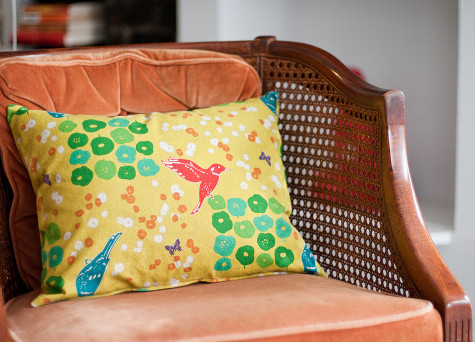
Project by Brett Bara:
Throw pillows are another fantastic way to incorporate cute textiles and DIY flair into your home without a great investment of time or money. If you’ve ever gone into a fabric store and wanted to buy everything because it’s just all so gorgeous, then pillows are a great way to put those fabrics to work in your decor. Bold or loud prints that would be too much used in large scale (like in curtains) can be just right for a little pillow pop on a sofa or bed.
I’m going to show you how to make a zippered pillow cover, which is easier than it sounds, I promise. It looks super-professional AND has the added bonus of being easily changeable—I love the idea of making tons of different pillow covers and just swapping them out whenever you want a little change in a room.
The best part? You can make the pillow shown here in less than an hour! –Brett Bara
A Word on Zippers
Ok, I know you’re not going to believe me when I say this, but installing a zipper is REALLY EASY. (There are many ways to install a zipper —some more refined than others—the method I’m sharing here is basic and very simple!) BUT, if installing a zipper feels like it’s just too much, don’t give up. I’ll give alternate instructions at the end for how to make a pillow without a zipper. Everybody happy now? Let’s get started!
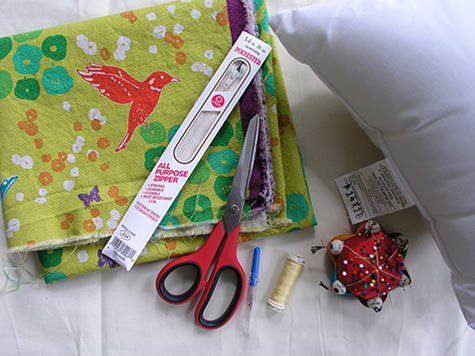
What You’ll Need
½ yard fabric (if your pillow is larger than 16”, you’ll need more fabric)
1 pillow form (buy this at a craft store or upholstery shop)
1 all-purpose zipper about 4” shorter than the edge of your pillow
Thread to match your fabric
Seam ripper
Sharp scissors
Straight pins
Tape Measure
Sewing machine
Zipper foot attachment for your sewing machine
Selecting and Preparing Fabric
Almost any type of fabric can be used for a throw pillow, but for beginners I recommend starting with medium-weight fabrics that are smooth in texture, like cottons or cotton-linen blends.
I’m using a Japanese print from the fantastic Etsuko Furuya for Echino line.
If your fabric is machine-washable, wash and dry it before sewing. This will pre-shrink the fabric, which is necessary to prevent the seams from puckering during future washings.
Finally, thoroughly iron the fabric before beginning.
Cutting
Cut two pieces of fabric that are the size of your pillow form plus 1” in length and 1” in width. So, if your pillow form is 12×16”, you’ll need two pieces of fabric that are 13×17”. This allows for ½” seam allowance on all seams.
Installing the Zipper
Place both pieces of fabric together with the right sides of the fabric facing each other and all corners aligned. (Be sure to situate both pieces so that the print pattern is facing in the same direction.)
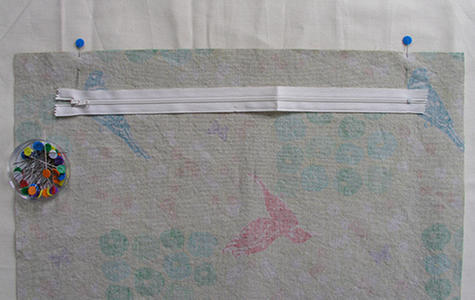
Center the zipper along what will be the bottom edge of the pillow, since you’ll want the zipper to be on the bottom edge of the finished pillow. (Here, my fabric is flipped with the bottom edge facing up, just to make it easier to work with). Place a pin near each end of the zipper, just INSIDE the metal stops at each end.
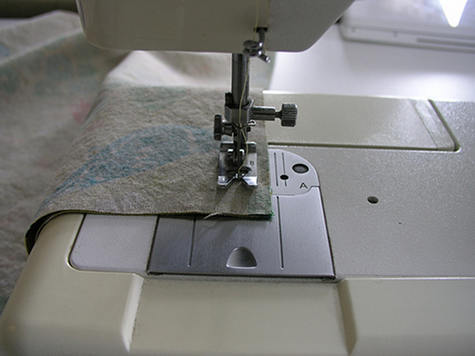
With a ½” seam allowance, sew the two segments on the outside of each pin. (This should be a short space of just a couple inches between the pins and the corners of the fabric.) Reinforce these seams by back-stitching at the beginning and end of each seam.

Next, change the stitch length on your machine to the longest length, which will allow you to baste the next seam. (Basting is sewing a long stitch which will later be removed; the long, loose quality of a basted stitch makes them easier to remove than regular stitches) With the stitch length set to long, simply sew the space in between the two short seams you just made. (Do not back-stitch to reinforce basted seams.)

Iron this seam open.
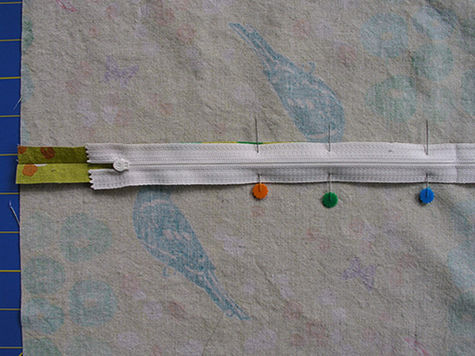
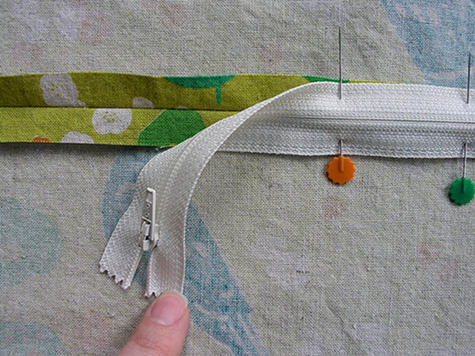
With the wrong side of the fabric facing up, place the zipper right-side down, aligning the zipper teeth directly over the seam. Pin it in place.
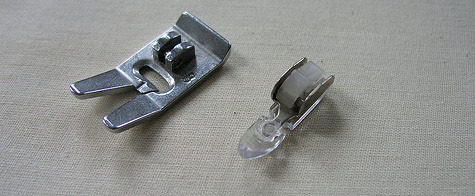
Change your machine’s presser foot to the zipper foot. Consult your manual for help with this if necessary; usually the feet snap off and on rather easily.
A zipper foot (shown here on the right) can be different for every sewing machine model, but it often looks like half of a standard presser foot (shown on the left). It allows you to sew right along the edge of the zipper teeth neatly and easily. The zipper foot has a little sliding part that changes it to a right or left position, so just slide it accordingly depending on whether you are sewing the right or left side of the zipper. (That means you have to pop off the zipper foot after sewing the right-side seam, slide the zipper foot thingie over to the left position, then pop the foot back on the machine. All this only takes a second once you get the hang of it!)
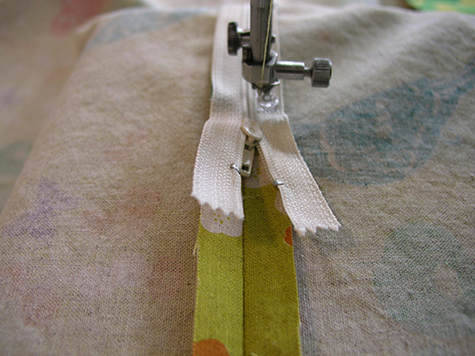
Note: Be sure your stitch length is back to normal length for the remainder of the sewing. Starting at the bottom of the zipper on the right side, with the zipper foot in the right-side position, sew down the side of the zipper. When you get near the end, stop the machine. Leave the needle in the work, but raise the foot, and gently move the zipper pull back behind the needle. Then lower the foot again and sew to the end of the zipper. Backstitch at the end of this seam.
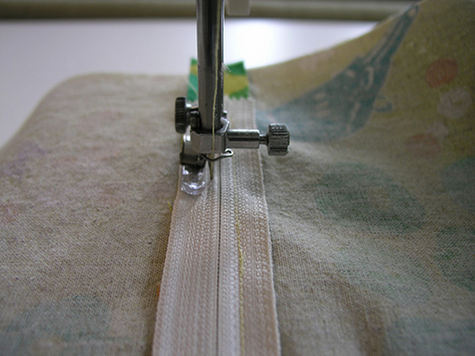
Next, change the zipper foot to the left position, and repeat this process on the left.
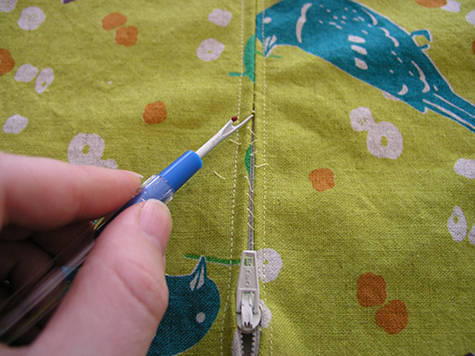
And your zipper is installed! (That wasn’t so bad, right?) The seam is still basted closed, so from the right side, use the seam ripper to gently remove the basted stitches. (They’ll pop out really easily; just pick out any remaining thread pieces that are left dangling.)
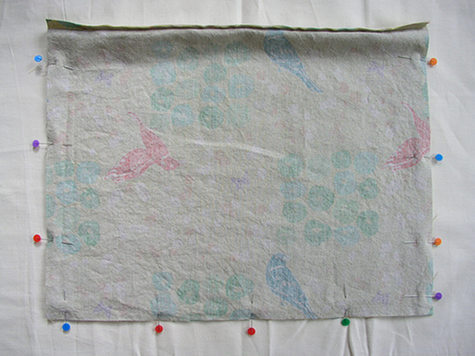
Change back to the standard presser foot. Fold the two pillow halves so that they are aligned with right sides facing each other and all corners and edges meeting. Pin in place. Sew around all three sides with a ½” seam allowance. (The fourth side, of course, is the side with the zipper installed.)
Here’s how to sew around the corners: when you reach each corner, leave the needle in the fabric and raise the presser foot, then pivot the fabric 90 degrees, lower the presser foot again, and continue sewing.
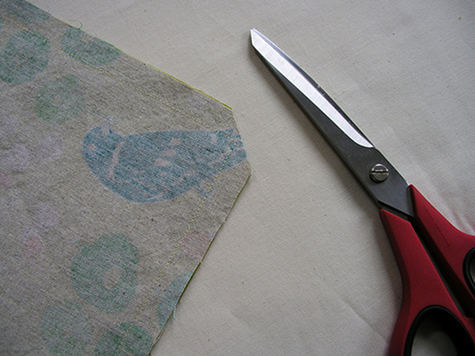
Clip the fabric at the corners. (Removing the excess fabric here helps give you a nice, sharp corner once you turn the pillow inside out.)
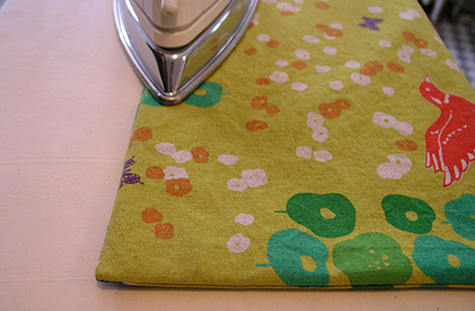
Turn the pillow cover inside out, ironing the seams flat.
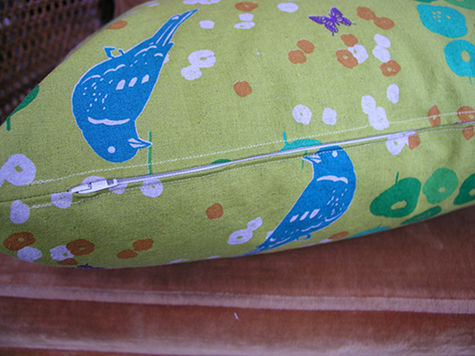
Insert the pillow form, and you’re done!
NOW FOR THE NO-ZIPPER PART
If you’d rather skip the zip, just use your sewing machine to sew the two pieces of fabric together around three edges, plus about 2” on each side of the fourth edge. Clip the corners and turn right-side out, iron the seam flat, then insert the pillow form. Using a needle and thread, hand-sew the opening closed. Of course, this pillow cover won’t be removable, but it will still be lovely!
18 notes
·
View notes
Text

エチノ
9.5号帆布 やや厚手
綿100% 110c巾
使い込む程に風合いがでる布です

手描き風ドット風
echinoサイン入りJAGUAR
堂々と歩く姿が魅力的

綿麻キャンバス
綿45%・麻55%
ツノを持つメガネの雄鹿
バイカラー
2色使いのコントラストが印象的

綿麻キャンバス
動物と草花
人気の定番組合せです

綿麻キャンバス
ボーダーと鳥
エチノ使いの色合いです
エプロン〜衣類〜インテリア
ポイントをいかした小物作りなど
個性的な作品がお作りになれます
4 notes
·
View notes
Note
Strawber reblogging Mentally Krill three times,,,, there must be a shrimple answer to this........
WJGSFHDGSFHOIEFH we'll have to echino-de-termine what the cause could be!
6 notes
·
View notes
Text

Made a new character for my Witch AU. This time it's Breezie.
Her real name is Delilah Echinos. She's part of Amy's former coven, and one of her main caretakers. She wasn't a great role model. She is very old despite her youthful appearance and had an affinity for wind-based magic. The spider on her hat is her familiar and his name is Anansi.
#sonic the hedgehog#breezie the hedgehog#sonic girl#witch#witch au#familiar#witch and familiar#flying#magic#spider#broom#breezie
5 notes
·
View notes
Text

shooting star
#maristela aphros#oh how ive missed drawing you#world residents#echino mesa#the mushlands + beyond#minecraft oc#art
6 notes
·
View notes
Text

♡Flower: Coneflower
Science: Coneflower is native to prairies and open woodlands of North America. It is named for the spiny cone-shaped flower center encircled by slender petals in shades of pink, purple or white. Newer varieties come in single and double forms and new coneflower colors such as orange, green, peach and coral.
Symbolism: Strength, healing, resilience, and vitality.
Fun Fact: The name coneflower comes from the Greek word echinos, which means "hedgehog". This refers to the flower's spiky, cone-shaped center.
Can you eat it?: Yes, some coneflowers are edible, including the purple and yellow coneflower.
0 notes
Text
“Echino Man”
© EricBrazier.com
#barrel cactus#cacti#Cactoideae#cactus#Echinocactus#Encino Man#ferocactus#Niagara Falls#niagara parks floral showhouse#Pachycereus marginatus
0 notes
